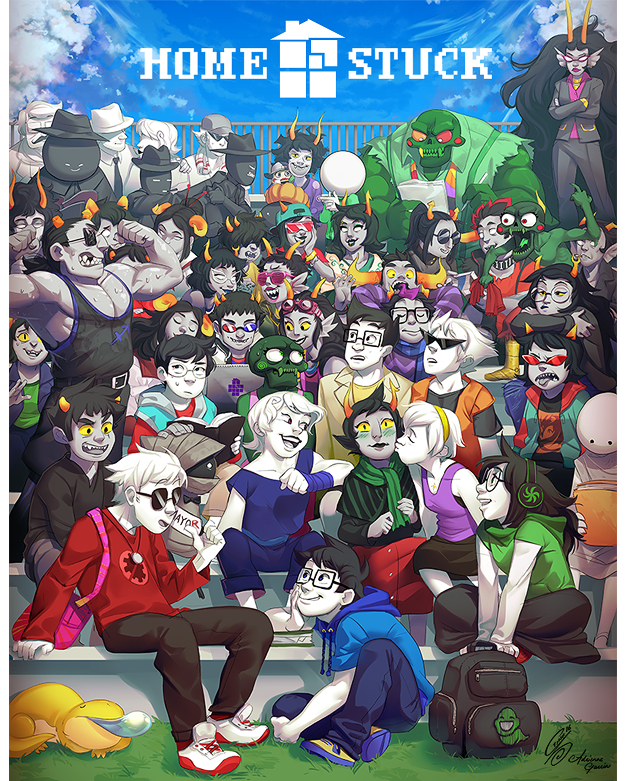Note: This contains mild spoilers, especially for Act 7/the ending.
Homestuck‘s 7 year run in April was notable for breaking the boundaries of webcomic storytelling, by using a mix of pictures, animations, minigames, music, and more text than War and Peace to depict a Creation Myth as Videogame that was also a meta-commentary on storytelling. Through Homestuck, writer Andrew Hussie plus many collaborators over the years have created a sprawling epic involving timeline-jumping, retroactive foreshadowing, multiple universes, copious 90s references, Internet culture, and a massive cast of characters, all very distinct with well-developed personalities, interests, and relationships (even those meant to be one-off jokes).
The diversity of its cast has especially been meaningful for Homestuck’s LGBTQ readers, who make up a significant portion of the fanbase. I reached out to a number of fellow LGBTQ female and non-binary fans of Homestuck to learn about what Homestuck means to them. Their responses cover the varied and respectful portrayal of queer characters, friendships, and relationships, the subversion of the Bury Your Gays trope, and the valuable opportunities in finding reflections of themselves, building relationships and community with other LGBTQ fans, and even becoming confident enough to own their identity.
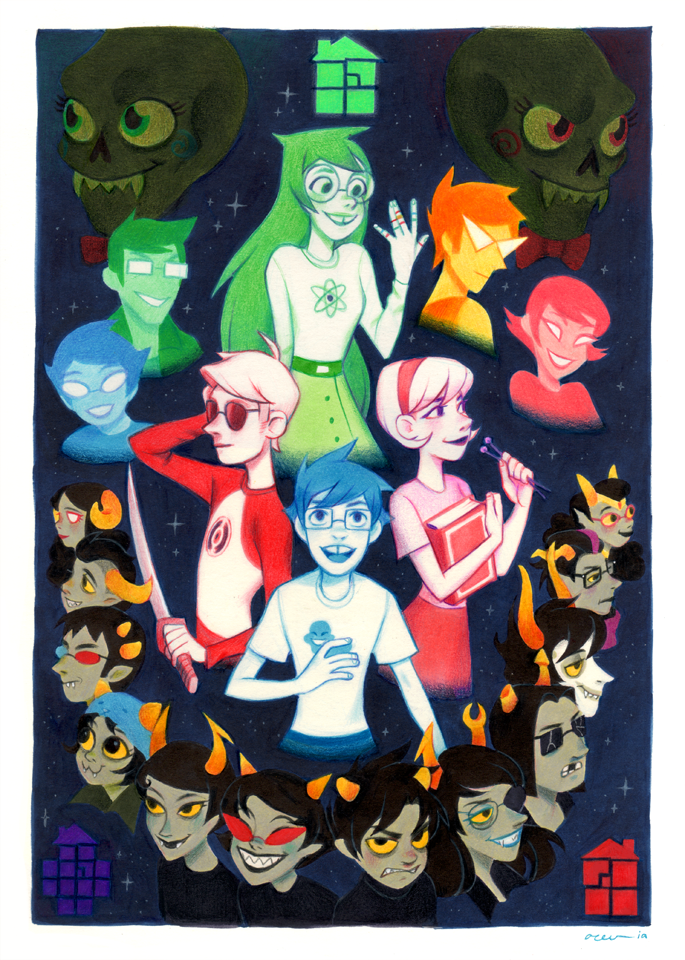
The main cast consists of teams of teenagers from three different universes (and multiple iterations of those universes) working together to play variations of Sburb, a game resembling a cross between The Sims, Spore, Myst, and RPGs whose end goal is to create a new universe. The three player races — humans, trolls, and cherubs — represent varying sexual orientations, but the trolls are particularly notable for their default bi/pansexuality; gender is not a factor in their highly complex “quadrant” relationship system.
The trolls’ default sexuality could be seen as a cop-out, as pointed out by 18-year-old transgender lesbian Roxie J., currently studying in the United Kingdom while volunteering for the Transgender Teen Survival Guide. The trolls do not go through struggles over their sexuality (in contrast to the humans: one of the most powerful moments of Homestuck involves Dave Strider coming to terms with how toxic masculinity affected his perception of heroism, manhood, and gayness). However, the normalization of queerness in the troll universe can have its benefits: “This must be incredible for all the bi and gay kids out there, reading it, and seeing loads of couples that don’t think twice about how they’re dating somebody of the same gender of themselves.”
“I sort of like that the trolls being bi isn’t treated as very important,” adds Middle Eastern lesbian Kayla B., who started reading Homestuck as a high school sophomore. “Sure, I like other women, but I’m also a poet, a textile artist, and a collector of fancy soaps. Those come first when I explain myself, and I like that the trolls also have features besides their sexuality that they discuss more.”
Some of these features have made certain characters fast favourites within the fanbase. Kayla and Hannah E., a 23-year-old queer non-binary web engineer living in Manila, were both heavily inspired by Vriska Serket, a polarizing firebrand troll who flits between antagonist and anti-hero. “[Vriska] made me realize that I didn’t always have to do what other people expected, and that it was OK for me to stand up for myself, even if other people disliked my autonomy,” says Kayla, while Hannah, who has been reading Homestuck since 2013, felt resonance in Vriska as someone living with Borderline Personality Disorder.
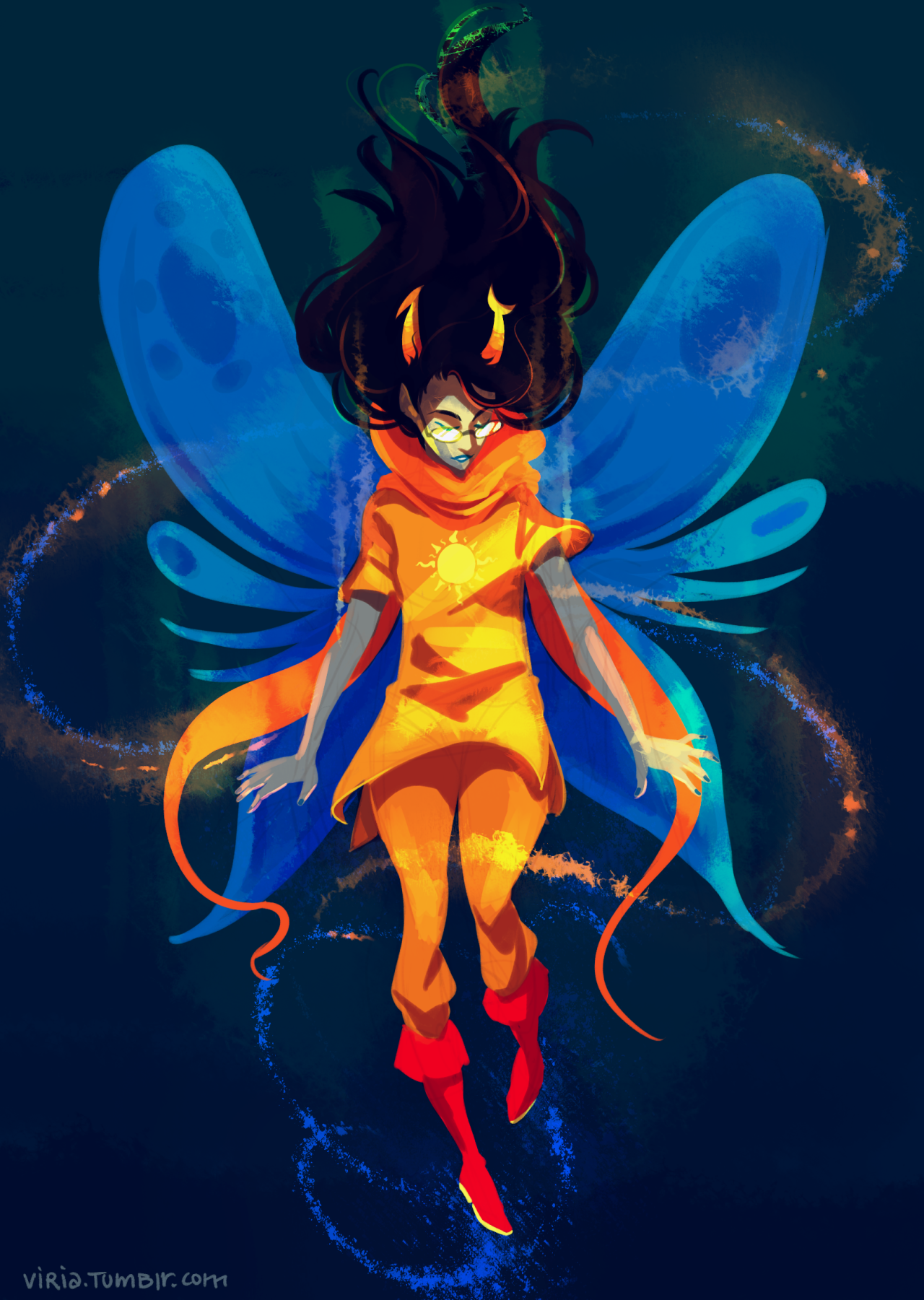
“She was an emotional wreck and it took a while for her to really come to terms with who she was as a person […] that was my struggle with BPD”, she explains. “I thought I was fucked up through and through, couldn’t get my emotions in check, felt too strongly about things. I’d do hurtful things to me and to other people on impulse and by the time I realized what I had done it’s too late. The damage was done. I earned a bad rep, like Vriska, so I rooted for her because I saw myself in her. I knew she wasn’t a bad person, she redeemed herself.”
For Roxie, Calliope — a kindly and creative cherub that shares a body with her more angry and misogynistic brother Caliborn, who ends up being one of the biggest villains — helped her find acceptance with her gender identity, relating to the idea of being tormented by her “male counterpart”.
“I felt I couldn’t separate “Roxie” from “[birth name]”, and that people would only ever see me as male,” she says. “Just as Calliope felt she could not be separated from the one who antagonized her the most, I felt I could not be separated from a group of people who are actually the most likely to harm me!”
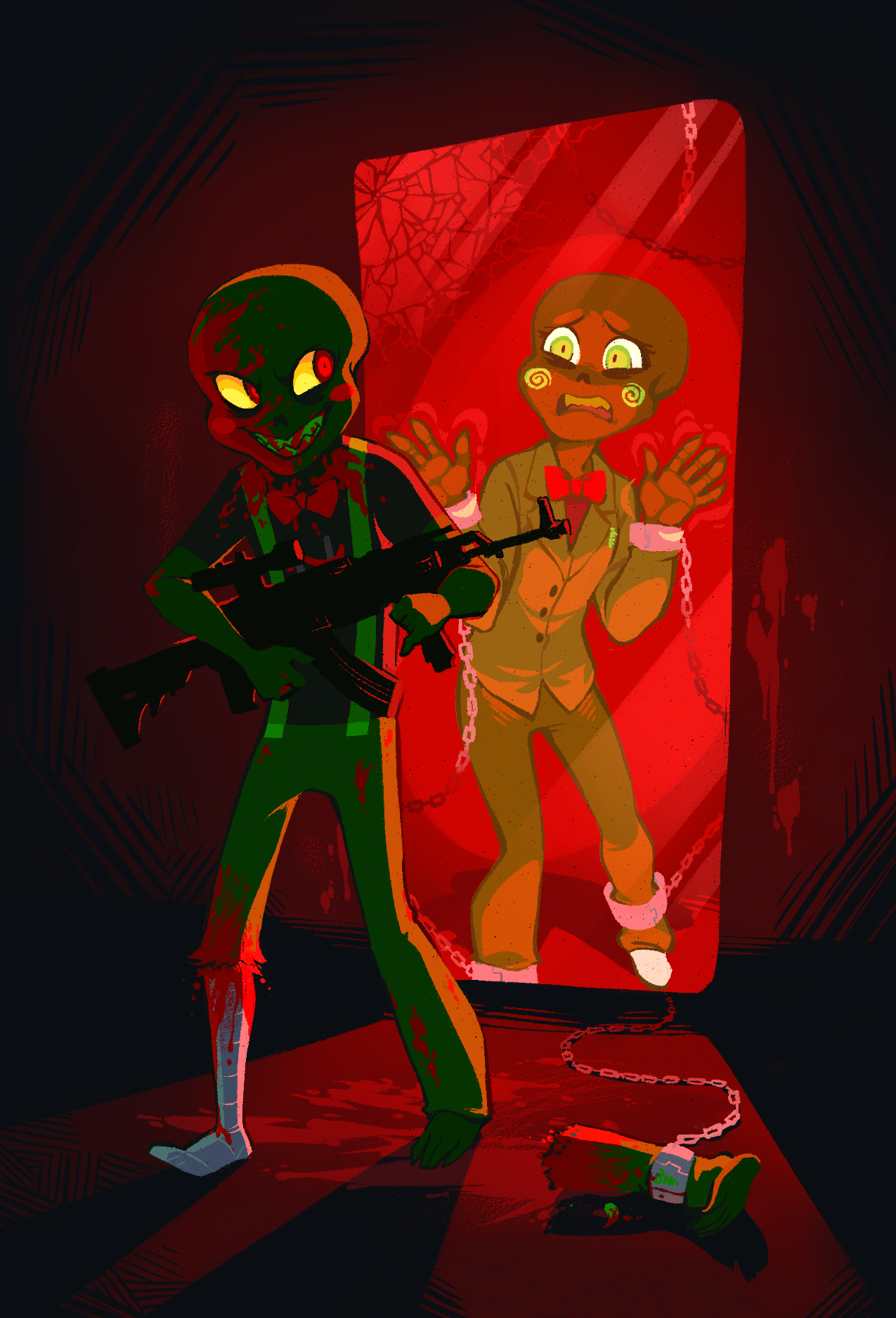
Roxie was most struck by how Calliope, who had low self-esteem due to her skull-monster appearance and sometimes sought to hide it, was reminded by other characters that she was already beautiful. “When you’re trans, and talk about how much you feel dysphoria, most people jump to telling you ‘Well, one day you can change that’ or ‘There’s always hormones’ or ‘You can have surgery when you’re older’,” she explains. The other characters’ acceptance of Calliope as she is “really reinforced that other girls will love me even if I don’t have the body I want to yet, or even ever.”.
The most popular canon same-sex female pairing in the fandom, by far, is of Kanaya Maryam and Rose Lalonde, a troll/human pairing whose love and shared struggle became core to Homestuck. 19-year-old Fenn, a lesbian from London who has been reading Homestuck since 2012, found joy in experiencing their romance, which eventually helped them be at ease with their sexuality: “I remember one of the times I was catching up on the colossal archive while my excited friend watched over my shoulder. I happened to be on a Rose and Kanaya log, and they asked: ‘Do you ship Rosemary? Good things happen with Rosemary.’ And good things happened indeed. When I reached the absolutely stunning panel where they kissed, I was practically giddy with glee. Suffice to say, I was in love with their love.”
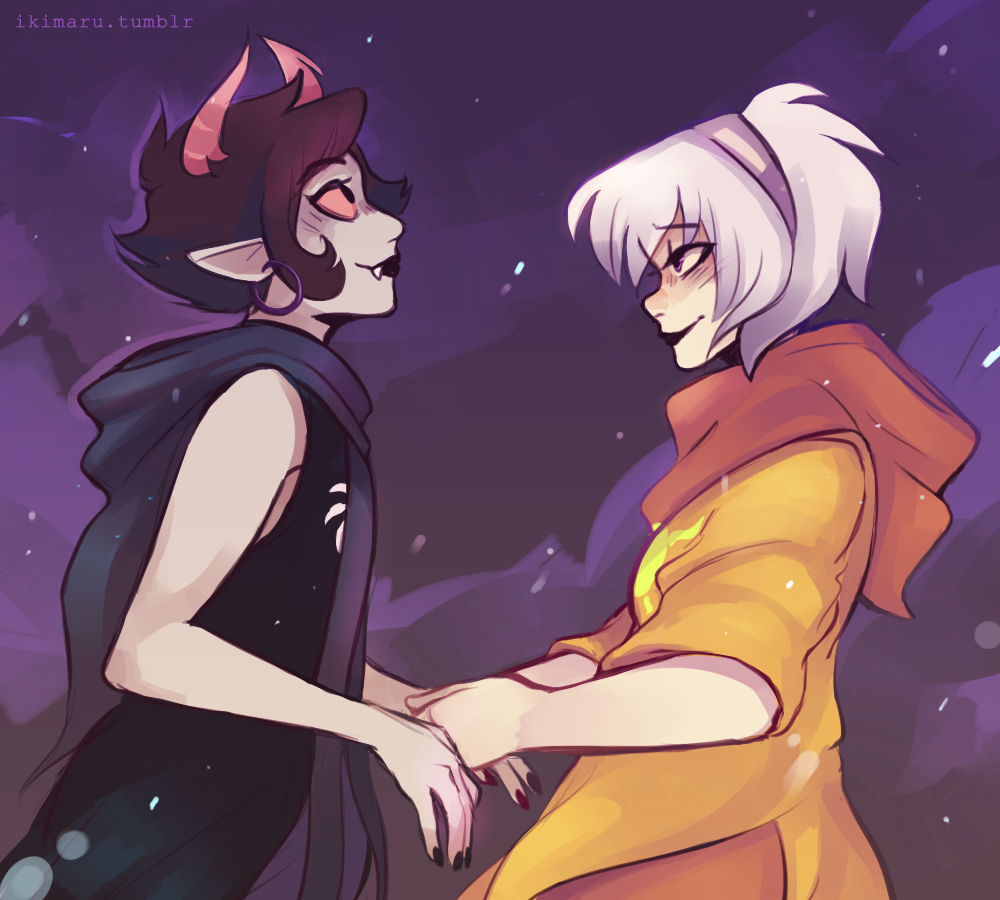
31-year-old London-based illustrator Kate Holden, who works with voiceover group Voxus on the highly popular fandub project Let’s Read Homestuck, directly credits her role as “teenage lesbian space vampire” Kanaya as the impetus for her acceptance of her own sexuality:
While I was lending my voice to Kanaya, she was quietly influencing me in her own helpful way. […] I’d been in the dark about my sexuality for a long time. I knew I wasn’t into guys, but attempts to discuss attraction to women were always met dismissively; I was too feminine in presentation, too introverted, too much of a straight arrow to be one of those lesbians, I was clearly just shy and not used to men yet. I decided to identify as Asexual, and was happy for a number of years as just that. But as I lent my voice to Kanaya’s understated yearning for the smart, driven and intimidating Rose Lalonde, it sparked recognition […] I realised we were both looking for the same thing.
There aren’t any overt trans characters in Homestuck, asides from the late addition of Davepetasprite2, a (highly adorable if strobe-y) fusion of the sprite forms of human male Dave Strider and troll female Nepeta Leijon that has a temporary but quickly resolved crisis over their gender and is now considered canonically non-binary. However, trans headcanons are common, especially with Roxy Lalonde, Rose’s mother/daughter whose name hinted at a possible trans history.
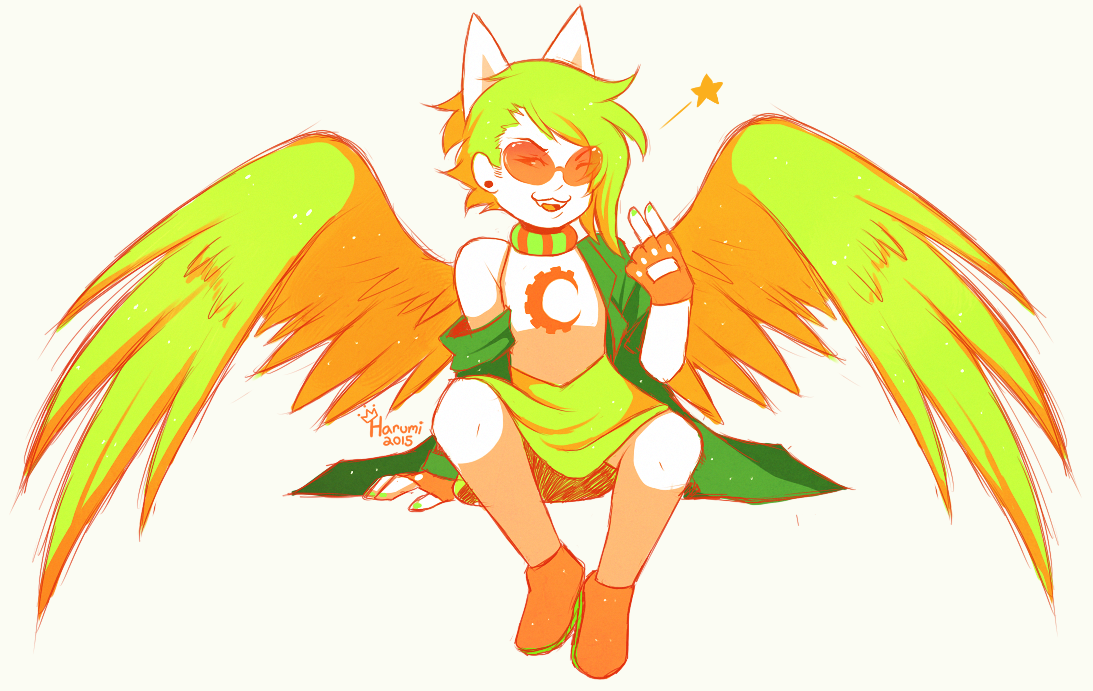
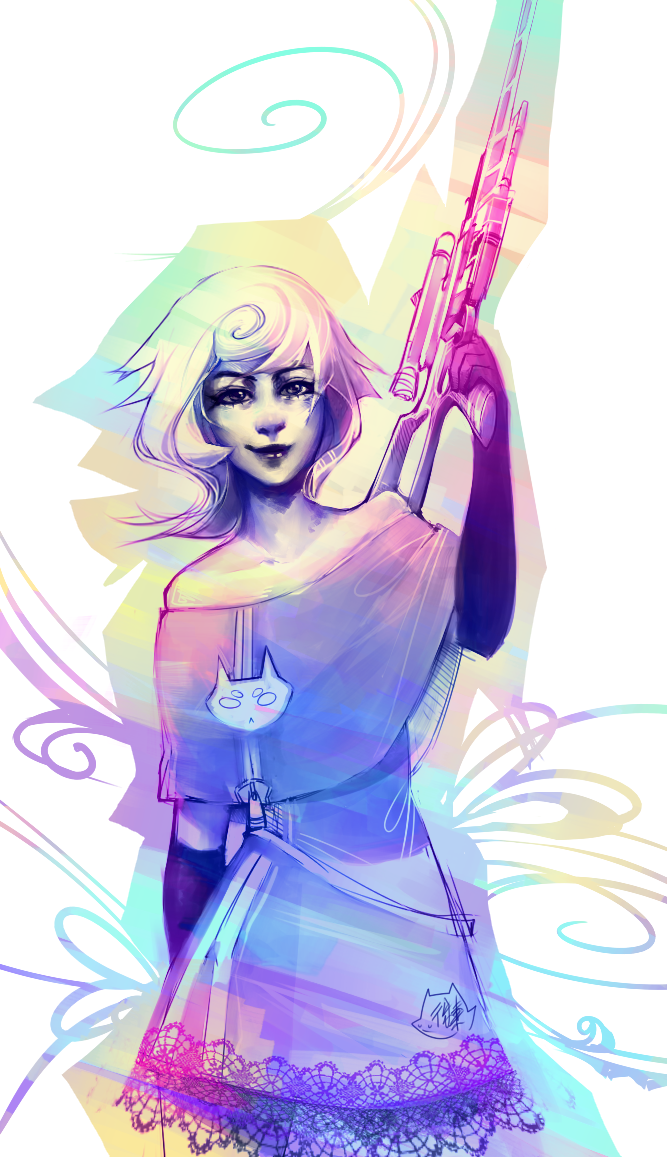
“When the last two letters of her first name are finally revealed, they’re referred to as ‘The final two chromosomic symbols’,” explains Roxie, who adopted Roxy’s name after admiring her ability to work through major issues like alcoholism as well as her interest in stereotypically-masculine things like science and technology while still being very feminine. “This was shocking to me because, well, I’m a girl with XY chromosomes. It really felt to me as if this was alluding to Roxy being trans, and regardless of whether she is or not, the line has cheered me up on many an occasion.”
Much of Homestuck’s success in portraying LGBTQ characters and relationships comes down to Hussie’s ability to write them in a realistic, non-fetishistic manner. For 24-year-old South American lesbian María, her trust in Hussie’s writing came from seeing moments in the story that reflected real life, even in very fantastical settings. As an example, she brings up Rose and Kanaya’s first date, “but neither of them are sure if it’s a date-date or if they’re just going out as friends. The very same thing had just happened to me days earlier. The whole thing with never being sure if it’s really a date because it’s not weird for two female friends to do things together? Perfect.”
Holden adds, “When straight and/or cis people write stories about Gender Sex Minority characters they have this tendency to focus on the drama of being different, and how exotic and exciting and tragic and maybe sexy that is to them, but what we actually want from stories is just the same as any bestselling romance or thriller or sci-fi or fantasy — but with more gender and sexual diversity. So maybe the guy gets the guy at the end, or the girl gets the girl, or somebody non-binary becomes happy in an asexual platonic relationship with lots of friends. We want to see ourselves having a happy ending, not to be tragedy porn for straight people to gasp, ‘oh they’re so brave!’ about.”
Homestuck’s finale, Act 7, was released on April 13, 2016, very soon after a lot of media uproar around the Bury Your Gays trope and the increasing numbers of female LGBTQ characters killed off on screen often for seemingly pointless reasons. Homestuck does have a reputation for its high death count: almost every character has died at least once, with multiple versions of the core cast having died multiple times. However, death does not render a character irrelevant: it is a necessary Leveling Up step for player characters to gain God Tier powers (kind of like superheros with conditional immortality) and many characters achieve greater prominence after their deaths, contributing to the story as ghosts or helper sprites. (Indeed, some characters, such as the predecessor troll players from a different timeline or Kanaya & Vriska’s teammate Aradia Megido, enter and influence the story as ghosts.)
Many fans see Homestuck’s use of death-as-equal-opportunity-narrative-device as a subversion of the Bury Your Gays trope. Both Kayla and María pointed out that narrative deaths only really count as Bury Your Gays if it resulted in a sheer reduction of LGBTQ characters in the story, was implied to happen due to their sexuality, or denies the opportunity for LGBTQ characters to achieve the same kind of happiness as straight characters — none of which applies to Homestuck.
Indeed, the finale of Homestuck, while ambiguous, implies a happy ending for many of its characters, including shots of Kanaya and Rose looking over their new world. Holden feels that the happiness of Rose and Kanaya in the endgame was crucial to the story’s success, and that Hussie understood this: “In spite of the meandering and pacing issues caused by the structure of Homestuck and how it was made, Hussie showed he pretty clearly understood what he was doing and how narratives work. There was so much build-up to Rose and Kanaya as a couple, they were both so clearly mutually devoted and they’d overcome so many issues in their relationship that it felt like their happiness was absolutely required for the ending result to be considered a success.”
For a media product primarily produced by a straight cis man, Homestuck has been able to achieve what many others are struggling to do: create a wide range of relatable narratives for LGBTQ readers, allowing them to find not only themselves but also friendships, communities, lovers, and family welcoming of their gender and sexual identities. It was willing to critique its own homophobia and present LGBTQ characters in fully realized ways. While the core webcomic itself has ended, its influence and spirit will live on — largely due to the respect it accorded its misfit ragtag fandom. Very apt for a story that started and ended with a group of Internet friends from different backgrounds getting together to have fun.
